

R PdLnX + −C≡N
III.2.13 Palladium-Catalyzed
Cross-Coupling Involving
-Hetero-Substituted Organometals
III.2.13.1 Palladium-Catalyzed Cross-Coupling
Involving Metal Cyanides
KENTARO TAKAGI
A. INTRODUCTION
Pd-catalyzed cross-coupling using CN as a carbon nucleophile was first reported for the reaction between aryl halides and KCN in 1973.[1] The cross-coupling is equivalent to the nucleophilic displacement of aryl halides with CN ; hence, it is also called cyanation. Up to that time the Rosenmund–von Braun reaction using a stoichiometric amount of CuCN as the cyanide source had been the sole method for carrying out this synthetically important transformation.[2] Thereafter, many studies investigated effective Pd catalysts, metal cyanides, solvents, or additives, intending to provide the efficient catalytic reactions of a variety of carbon electrophiles including aryl halides under mild conditions (Scheme 1). This Pdcatalyzed method has occasionally been called modestly reliable in terms of reproducibility. This largely stems from the fact that CN plays the role of an inhibitor in the catalytic reaction due to its coordination to the Pd2 or Pd0 species, besides the role of an indispensable reaction component. In general, metal cyanides dissolve only partially in the solvent. However, free CN can deactivate Pd complexes to a significant extent. Therefore, in order to provide an efficient catalytic reaction, it is critical to select the proper combination of metal cyanides and solvents or to use the appropriate additives like a crown-ether to keep the concentration of free CN moderately low. The choice of phosphorus ligands is also a determinate, especially for the reaction using relatively unreactive substrates.
B. CYANATION OF ARYL, ALKENYL, AND SOME
OTHER HALIDES AND TRIFLATES
The order of reactivity of the aryl electrophiles in Pd-catalyzed cyanation is as follows: aryl iodides aryl triflates aryl bromides aryl chlorides. The lower the reactivity of the
Handbook of Organopalladium Chemistry for Organic Synthesis, Edited by Ei-ichi Negishi ISBN 0-471-31506-0 © 2002 John Wiley & Sons, Inc.
657
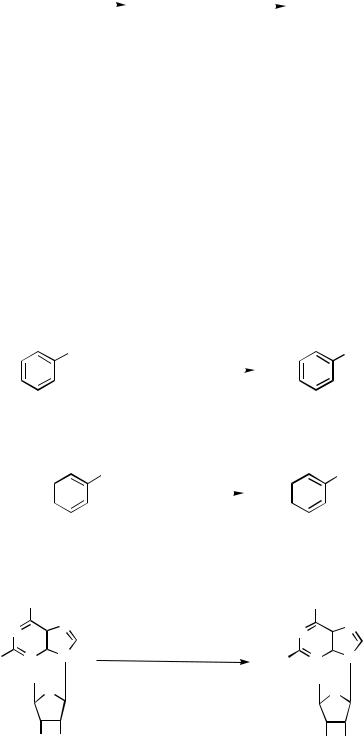
658 III Pd-CATALYZED CROSS-COUPLING |
|
|
|
|
||||
RX |
cat. PdLn |
−C=N |
|
|
C=N |
|||
|
R |
|
PdLnX |
|
R |
|
||
R = carbon group; X = halogen, OTf, etc.
Scheme 1
substrate, the more strict the control of reaction conditions required as noted above (Table 1). For the reaction of the aryl iodides, not only Pd(PPh3)4[3] but also phosphine-free Pd0, that is, the one generated in situ from Pd(OAc)2 and a reducing reagent like NaOEt (Scheme 2)[4],[5] or Pd2(dba)3[6], is available as a catalyst. In the reaction, KCN is often used as the metal cyanide and polar solvents such as NMP, HMPA, DMF, or THF are used as the reaction media. A reaction temperature of around 60 –100 °C is usually necessary. Due to the problem of solubility, NaCN is not the first choice for the metal cyanide. However, NaCN sometimes shortens the reaction time compared with the reaction using KCN as the metal cyanide, if NaCN does not disturb the catalytic reaction. A modified metal cyanide like Me3SiCN (Scheme 3),[7] Me3SnCN,[8] or Bu3SnCN[9],10] can be used in place of KCN but the special advantage over KCN is not observed for the reactions using aryl halides as the substrates. Impregnation onto Al2O3 or the addition of Al2O3 is also a useful method for modifying NaCN. Such a modified NaCN is available for the catalytic reaction of aryl halides including bromobenzene in toluene using Pd(PPh3)4 as the catalyst.[11] For the synthesis of the cyano-deriv- atives of adenocine (Scheme 4)[9],[10] or the precursor of ( )-estradiol (Scheme 5)[12] from the corresponding aryl halides, modified metal cyanides were used as the cyanide sources.
|
|
I |
1.4 equiv KCN |
|
|
CN |
|
|
|
|
|
|
|
R |
|
|
|
R |
|
|
|
|
|
|
|
1 mol % Pd(OAc)2 HMPA (NaOEt include), 100 °C
R, Reaction time (h), GLC yield (%), Remark[4] = H, 4.5, 98, -; p-CH3, 2, 93, -; o-CH3, 2, 96, -; m-Cl, 5.5, 70, m-CN (21%); p-NO2, 10, 70, -.
|
|
|
|
|
Scheme 2 |
|
|
|
|
|
|
|
|
I |
1.5 equiv Me3SiCN |
|
|
|
CN |
R |
|
|
|
|
R |
|
|
|
|
|
|
|
|
2 mol % Pd(PPh3)4 |
|
|
|
||
|
|||||||||
|
|
|
|
|
|
|
|
|
|
|
|
|
|
|
Et3N, reflux, 10−30 min |
|
|
|
|
R, Isolated yield (%), Remark[7] = H, 88, -; o-CH3, 76, -; p-CH3O, 89, -; p-Cl, 70, -; p-Br, 56, p-CN (15%); p-I, 53, p-CN; p-CH3O2C, 68, -.
|
|
|
|
Scheme 3 |
|
|
|
|
|
NH2 |
|
|
NH2 |
|
|||
|
N |
|
N |
|
N |
|
N |
|
I |
|
N |
1.1 equiv Bu3SnCN |
|
N |
|||
|
|
|
|
|||||
N |
NC N |
|||||||
|
||||||||
|
15 mol % Pd(PPh3)4 |
|
||||||
|
HO CH2 |
|
HO CH2 |
|
||||
|
|
DMF, 120 °C, 20 h |
|
|||||
|
|
O |
|
86%[10] |
|
O |
|
|
|
HO |
OH |
|
HO OH |
||||
Scheme 4

III.2.13.1 CROSS-COUPLING INVOLVING METAL CYANIDES |
659 |
TABLE 1. Pd-catalyzed Cyanation of Halobenzenes and Phenyl Triflate
|
|
|
|
Reaction |
|
|
Aryl |
Metal |
|
|
Temperature |
Yield b |
|
Compound |
Cyanide |
Catalysta |
Solvent |
(°C) |
(%) |
Reference |
|
|
|
|
|
|
|
PhI |
KCN |
Ia |
HMPA |
100 |
98 |
4 |
PhI |
KCN |
Ib |
HMPA |
60 |
99 |
4 |
PhI |
KCN |
IIa |
THF |
Reflux |
98 |
3 |
PhI |
KCN |
IIIa |
NMP |
60 |
40 |
6 |
PhI |
Me3SiCN |
IIb |
Et3N |
Reflux |
98 |
7 |
PhI |
Me3SnCN |
IIc |
CH2Cl2 |
40 |
36 |
8 |
PhI |
NaCN-Al2O3 |
IId |
Toluene |
80 |
98 |
11 |
PhI |
Zn(CN)2 |
IIb |
DMF |
80 |
(92) |
13 |
PhI |
KCN |
IIIb |
NMP |
60 |
98 |
20 |
PhI |
H11CN, KOH |
IIe |
THF |
90 |
95 5c |
28 |
PhI |
NaCN |
IV |
Dioxane |
Reflux |
91 |
33 |
PhI |
NaCN, ZnCl2 |
V |
Heptane, H2O |
Reflux |
99 |
31 |
PhI |
KCN |
IIf |
THF |
Reflux |
100d |
32 |
PhBr |
KCN |
Ib |
HMPA |
90 |
94 |
4 |
PhBr |
NaCN |
IIg |
Toluene |
80 |
98 |
11 |
PhBr |
Zn(CN)2 |
IIh |
DMF |
80 |
(94) |
13 |
PhBr |
KCN |
IIi |
Benzene |
100 |
93e |
26 |
PhBr |
H11CN, KOH |
IIe |
THF |
90 |
90c |
28 |
PhBr |
Zn(CN)2 |
IIIc |
Wet DMF |
120 |
(95) |
22 |
PhBr |
NaCN |
IV |
Dioxane |
Reflux |
85 |
33 |
PhCl |
H11CN, KOH |
IIe |
THF |
90 |
45c |
28 |
PhCl·Cr(CO)3 |
H11CN, KOH |
IIj |
DMSO |
135 |
95c |
28 |
PhCl |
Et4NCN |
IIk |
DMF f |
130 |
96g |
39 |
PhOTf |
KCN |
IIId |
NMP |
60 |
94 |
19 |
PhOTf |
H11CN, KOH |
IIe |
THF |
90 |
62c |
28 |
aIa 1 mol % Pd(OAc)2, NaOEt. Ib 1.5 mol % Pd(OAc)2, KOH, KI. IIa 1 mol % Pd(PPh3)4. IIb 2 mol % Pd(PPh3)4. IIc 18 mol % Pd(PPh3)4. IId 10 mol % Pd(PPh3)4. IIe 2 – 4 mol % Pd(PPh3)4, kryptofix© 2.2.2. IIf 5 mol % Pd(PPh3)4, CuI. IIg 10 mol % Pd(PPh3)4, Al2O3. IIh 6 mol % Pd(PPh3)4. IIi 20 mol % Pd(PPh3)4,18-crown-6. IIj 2 – 13 mol % Pd(PPh3)4. IIk 0.125 mol % Pd(PPh3)4, -0.3 to -0.8 V (reducing potential). IIIa 0.5 mol % Pd2(dba)3.CHCl3. IIIb 0.5 mol % of Pd2(dba)3.CHCl3, dppf. IIIc 0.05 mol % Pd2(dba)3, dppf. IIId 2 mol % Pd2(dba)3.CHCl3, dppf. IV 0.3 mol % PhPdBr{PPh2(bc-5)}2.V 2mol % PdCl2{PPh2(ms)}2, NaBH4.
bGLC yield. Yields in parentheses are isolated ones.
cRadiochemical yield.
dConversion.
eThe yield is not specified as GLC or isolated.
f0.1 M solution of Et4NCl.
gNumber of catalyst turnovers.
Although the Pd(PPh3)4-catalyzed cyanation of aryl bromides with KCN or NaCN does not take place under ordinary conditions, Zn(CN)2 as the cyanide source enables the reaction in DMF at 80 C. The solubility of Zn(CN)2 is lower than that of KCN or NaCN and the covalency of the Zn – CN bond is higher than that of K– C N or Na – CN. Therefore, the concentration of free CN must be a minimum in the reaction solution using Zn(CN)2 as the metal cyanide. Thus, Zn(CN)2 is probably able to maintain the active form of the Pd0 catalyst over a longer period of time than KCN or NaCN (Scheme 6).[13],[14] Zn(CN)2 is also an effective cyanide source for the Pd0-catalyzed reaction of aryl triflates (Schemes 7–10).[15]–[18]
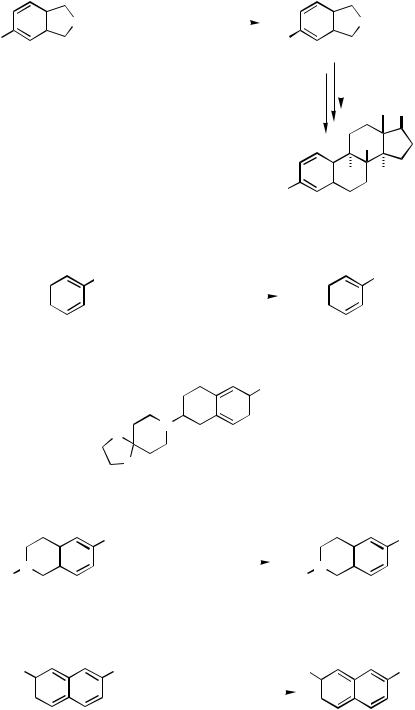
660 |
III |
Pd-CATALYZED CROSS-COUPLING |
|
|
|
||
|
|
|
SO2 |
NaCN supported on Al2O3 |
|
|
SO2 |
|
|
|
|
|
|||
|
|
|
|
|
|
||
|
|
|
10 mol % Pd(PPh3)4 |
|
|
||
|
I |
|
|
NC |
|||
|
|
|
Toluene, 100 °C, 3 h |
||||
|
|
68%[12] |
|
|
|
||
|
|
|
|
|
|||
|
|
|
|
|
|
|
|
OH
|
|
|
|
|
|
|
|
|
H |
|
|
|
|
|
|
|
|
|
H H |
|
|
|
|
|
|
|
|
|
|
|
|
|
|
|
HO |
||||
|
|
|
|
|
(+)-Estradiol |
||||
|
|
|
|
Scheme 5 |
|||||
|
|
|
X |
0.6 equiv Zn(CN)2 |
|
CN |
|||
|
|
|
|
|
|||||
R |
|
|
|
|
R |
|
|
|
|
|
|
|
|
2−6 mol % Pd(PPh3)4 |
|
||||
|
|
|
|
DMF, 80 °C |
|||||
R (or 1), X, Reaction time (h), Isolated yield (%)[13] = H, I, 0.5, 92; p-CH3O, I, 0.5, 92; 2-NH2-5-CH3CO, I, 0.5, 90; H, Br, 6, 94; p-CH3CO, Br, 5.5, 91; p-CH3O, Br, 7, 95; p-CH3, Br, 6, 84; p-NO2, Br, 6, 92; (1), Br, 5−6, 92.
|
|
|
|
|
|
Br |
|
|
|
|
|
|
|
|
|
|
|
|
|
|
|
|
|
|
|
|
|
|
|
|
|
|
|
|
O |
N |
|
|
|
|
|
||
|
|
|
|
|
|
|
|
|
||
|
|
|
O |
1 |
|
|
|
|
|
|
|
|
|
|
Scheme 6 |
|
|
|
|
|
|
|
|
OTf |
0.7 equiv Zn(CN)2 |
|
|
|
|
CN |
||
N |
|
|
|
|
|
N |
|
|||
|
|
|
|
|
|
|||||
|
|
|
|
|
|
|
|
|||
|
|
|
4 mol % Pd(PPh3)4 |
|
Boc |
|
||||
Boc |
|
|
|
|
|
|
|
|||
|
|
|
|
DMF, 80 °C, 45 min |
|
|
|
|
|
|
|
|
|
|
78%[15] |
|
|
|
|
|
|
|
|
|
|
Scheme 7 |
|
|
|
|
|
|
CH3O |
|
OTf |
|
|
CH O |
|
|
CN |
||
|
|
|
|
0.6 equiv Zn(CN)2 |
3 |
|
|
|
||
|
|
|
|
|
|
|
|
|
||
|
|
|
|
|
|
|
|
|
|
|
1. 5 mol % Pd(OAc)2, 5 mol % PPh3 NMP, 160 °C, 30 min
2. 1.5 mol % Pd(OAc)2, 160 °C, 1h
86%[16]
Scheme 8
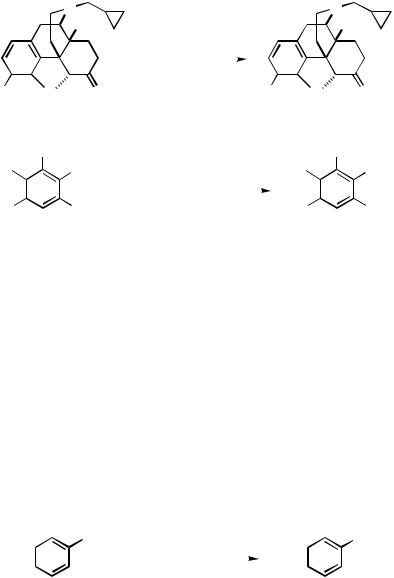
|
|
|
|
|
III.2.13.1 |
CROSS-COUPLING INVOLVING METAL CYANIDES 661 |
||||||||||
|
|
|
|
|
N |
|
|
|
|
|
|
|
|
N |
||
|
|
|
|
|
OH |
2 equiv Zn(CN)2 |
|
|
|
|
|
|
|
OH |
||
|
|
|
|
|
|
|
|
|
|
|
||||||
|
|
|
|
|
|
|
|
|
|
|
||||||
|
|
|
|
|
|
|
|
|
|
|
|
|
|
|
|
|
|
|
|
|
|
|
|
|
|
|
|
|
|
|
|
|
|
|
|
|
|
|
|
|
|
4 mol % Pd(PPh3)4 |
|
|
|
|
|
|
|
|
|
|
|
|
|
|
|
|
|
|
|
|
|
|
|
|
|
TfO |
|
O |
O |
DMF, 120 °C, 9h |
NC |
|
O |
|
O |
|||||||
|
39%[17] |
|
|
|||||||||||||
|
|
|
|
|
|
|
|
Scheme 9 |
|
|
|
|
|
|
|
|
|
|
R1 |
|
|
|
|
|
|
|
|
|
|
|
R1 |
||
R2 |
|
|
|
|
OTf |
1.2 equiv Zn(CN)2 |
|
|
R2 |
|
CN |
|||||
|
|
|
|
|
|
|
|
|
|
|
|
|
|
|
|
|
|
|
|
|
|
|
|
|
|
|
|
|
|
|
|
|
|
R3 |
|
|
|
|
OTf |
4 mol % Pd2(dba)3 |
|
|
R3 |
|
CN |
|||||
|
|
|
|
|
|
|
||||||||||
|
|
|
|
16 mol % dppf |
|
|
|
|||||||||
|
|
|
|
|
|
|
|
|
|
|
|
|
|
|
|
|
DMF, 2 h
R1, R2, R3 (or R1, R2-R3), Reaction temperature (°C), Isolated yield (%)[18] = H, CH3, H, 70, 92; CH3, H, H, 90, 88; H, CO2C2H5, H, 60, 98; (CH2)4CO2CH3, H, H, 90, 81; H, CH2CH(NHBoc)-
CO2CH3, H, 60, 95; H, C2H4CO2C2H5, C2H4CO2C2H5, 60, 75; (H,—CH=CH—CH=CH—), 70, 85.
Scheme 10
Pd0 containing the dppf ligand exhibits a higher catalytic efficiency than Pd(PPh3)4 for the cross-coupling, partly because of the robust binding of dppf to Pd0 compared with PPh3. The complex is usually prepared in situ from Pd2(dba)3 or Pd(dba)2 and dppf and enables the reaction of aryl iodides or aryl triflates with KCN in NMP or DMF (Schemes 11 and 12).[6,18]–[20] This catalyst is utilized in the synthesis of benzodiazepine derivatives (Scheme 13).[21] When Zn(CN)2 is used as the cyanide source, the catalytic cyanation of aryl bromides and even one of aryl chlorides are achieved by the catalyst system in wet DMF and N,N-dimethylacetamide, respectively. Reactions of aryl bromides or electron-deficient aryl chlorides take place at 120 °C and ones of electron-rich aryl chlorides take place at 150 °C (Schemes 14 and 15).[22],[23] Pd(dppf )2 or Pd0, generated in situ from Pd2 , dppf, and Zn, enables the catalytic reaction of aryl bromides with KCN (Scheme 16).[24]
|
|
|
|
I |
2 equiv KCN |
|
CN |
||
|
|
|
|
|
|
||||
R |
|
|
|
|
|
R |
|
|
|
|
|||||||||
0.5 mol % Pd2(dba)3·CHCl3 2 mol % dppf
NMP, 60 °C
R, Reaction time (h), Isolated yield (%), Remark[20] = p-COCH3, 2, 94, -; p-Cl, 2, 93, -; p-CH3, 4, 94, -; p-CH3O, 1, 92, 80 °C; m-CO2CH3, 2, 96, -; o-CO2CH3, 8, 93, -; o-CH3, 4, 87, -.
Scheme 11
The utility of additives often provides a beneficial effect on the cross-coupling reaction using CN as the carbon nucleophile by adjusting both the concentration and the reactivity of CN in the reaction media. First, the addition of a phase-transfer catalyst (PTC) like 18-crown-6 (Schemes 17 and 18),[25]–[27] kriptofix© 2.2.2,[28] or 12-crown-4 (Scheme 19)[29],[30] to the reaction mixture allows the Pd(PPh3)4-catalyzed
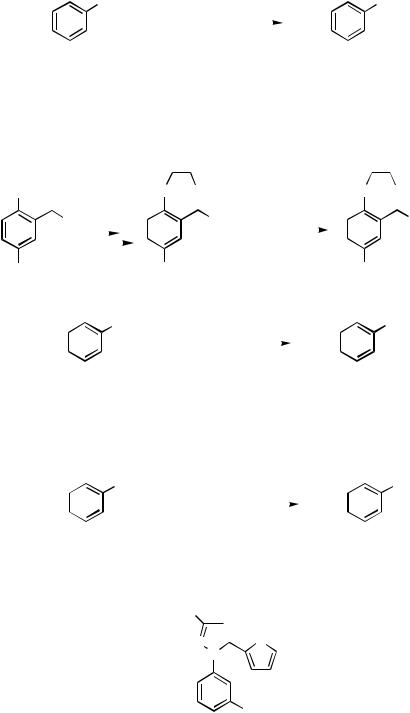
662 |
III Pd-CATALYZED CROSS-COUPLING |
|
|
|
|||
|
|
|
OTf |
|
|
CN |
|
|
R |
|
|
2 equiv KCN |
R |
|
|
|
|
|
|
|
|
||
2 mol % Pd2(dba)3·CHCl3 8 mol % dppf NMP, 60 °C
R (or Ar), Reaction time (h), Isolated (or GLC) yield (%)[20] = H, 8, (94); p-COCH3, 3, 92; p-Cl, 3, (94); p-CH3, 25, 87; p-CN, 2, 95; p-CO2CH3, 3, 94; p-NO2, 2, 90;
p-C6H5, 8, 92; p-CH3O, 25, (45); p-NHCOCH3, 25, (35); (2-Naphthyl), 4, 91; (2-Oxo-2H-benzopyran-7-yl), 2, 98; (8-Quinolyl), 2, 95.
|
|
|
|
|
|
|
|
|
|
Scheme 12 |
|
|
|
|
|
|
|
|
|
|||
OH O |
CH3N |
N |
|
|
|
|
CH3N |
N |
||||||||||||||
|
|
Ph |
|
|
|
Ph |
KCN |
|
|
|
|
Ph |
||||||||||
|
|
|
|
|
|
|
|
|
||||||||||||||
|
|
|
|
|
||||||||||||||||||
|
|
|
|
|
|
|
|
|
|
|
|
|
|
|
|
|
|
|
|
|||
|
|
|
|
|
|
|
|
|
|
|
|
|
cat. Pd2(dba)3, dppf |
|
|
|
|
|
||||
|
|
|
|
|
|
|
|
|
|
|
|
|
|
|
|
|
|
|||||
|
|
|
|
|
|
|
|
|
|
|
|
|
|
|
|
|
||||||
|
|
|
|
|
|
|
|
|
|
|
|
|
|
NMP |
|
|
|
|
|
|||
OH |
|
OTf |
78%[21] |
|
|
|
|
CN |
||||||||||||||
|
|
|
|
|
|
|
||||||||||||||||
|
|
|
|
|
|
|
|
|
|
Scheme 13 |
|
|
|
|
|
|
|
|
|
|||
|
|
|
|
|
|
|
Br |
|
0.6 equiv Zn(CN)2 |
|
|
|
|
|
|
CN |
||||||
R |
|
|
|
|
|
|
|
|
|
|
R |
|
|
|
|
|
|
|||||
|
|
|
|
|
|
|
|
|
|
|
|
|
|
|
||||||||
|
|
|
|
|
|
|
|
|
|
|
|
|
|
|
|
|
|
|
|
|||
0.05 mol % Pd2(dba)3
0.12 mol % dppf wet DMF, 120 °C
R (or Ar), Reaction time (h), Isolated yield (%)[22] = H, 72, 95; o-CH3O, 72, 87; (1-Naphthyl), 72, 91; (2-Methyl-6-amino-3-pyridyl), 20, 94.
|
|
|
|
|
Scheme 14 |
||||
|
|
|
Cl |
|
0.6 equiv Zn(CN)2 |
|
CN |
||
|
|
|
|
|
|
||||
R |
|
|
|
|
|
R |
|
|
|
|
|
|
|
|
2 or 4 mol % Pd2(dba)3 |
|
|||
|
|
|
|
4 or 8 mol % dppf, 12 or 24 mol % Zn |
|||||
|
|
|
|
|
DMA |
||||
R (or Ar or 2), Reaction time (h), Reaction temperature (°C), Isolated yield (%)[23] = o-F, 12, 150, 85; o-CO2CH3, 2, 120, 93; p-CH3O, 4, 150, 88; m-CO2CH3, 10, 120, 91; p-CO2CH3, 2, 120, 97; p-CHO, 0.75, 120, 92; (1-Naphthyl), 2, 150, 96; (2), 10, 150, 91.
CF3
N  O
O
N
Cl
2
Scheme 15
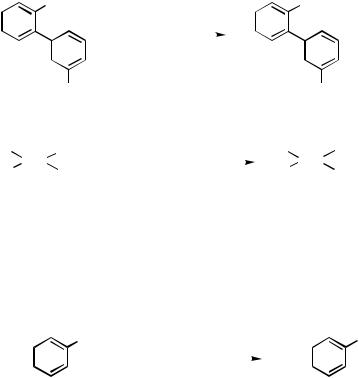
|
|
|
III.2.13.1 |
CROSS-COUPLING INVOLVING METAL CYANIDES 663 |
|||||||
|
|
Br |
|
|
|
|
CN |
||||
|
|
|
|
|
|
KCN |
|
|
|
||
|
|
|
|
|
|
|
|
|
|||
|
|
|
|
|
|
|
|
|
|||
|
|
|
|
|
|
|
|
|
|
|
|
|
|
|
|
|
|
2 mol % Pd(dppf)2 |
|
|
|
||
|
|
|
|
|
|
|
|
|
|||
|
|
|
|
|
|
5 mol % Zn(CN)2 |
|
|
|
||
|
|
|
|
|
|
|
|
|
|||
|
|
|
|
|
|
DMF, 85 °C, 18 h |
|
|
|
||
|
|
|
CO2CH3 |
98%[24] |
|
|
|
|
CO2CH3 |
||
|
|
|
|
|
|
|
|
||||
|
|
|
|
|
|
Scheme 16 |
|
|
|
||
R1 |
|
R3 |
2 equiv KCN |
R1 |
|
R3 |
|||||
R2 |
C=C |
|
|
|
|
R2 |
C=C |
||||
|
X |
3 mol % Pd(PPh3)4 |
|
CN |
|||||||
7.6 mol % 18-crown-6, Benzene
R1, R2, R3, X, Reaction temperature (°C), Reaction time (h), Isolated (or GLC) yield (%), Isomeric purity (%), Remark[25] = Ph, H, H, Br, 70 −75, 2, 94, 97, -; Ph, H, H, Br, 70 −75, 2, 95, 97, NaCN
and 15-crown-5; Ph, H, H, Cl, 95–100, 15, 84, 97, -; H, Ph, H, Br, 55–60, 6, 94, 97, -; C4H9, H, H, Br, 100, 12, (96), 99, -; H, C4H9, H, Br, 100, 12, (98), 99, -; Ph, CH3, H, Br, 90 –95, 10, 93, 92, -; Ph, Ph, H, Br, 90 –95, 5, 98, -, -; Ph, Ph, Ph, Br, 90 –95, 15, 85, -, -.
|
|
|
|
|
|
Scheme 17 |
||||
|
|
|
|
|
Br |
1 equiv KCN |
|
CN |
||
|
|
|
|
|
|
|
||||
R |
|
|
|
|
|
|
R |
|
|
|
|
|
|
|
|
|
20 mol % Pd(PPh3)4 |
|
|||
|
|
|
|
|
|
40 mol % 18-crown-6 |
||||
|
|
|
|
|
|
Benzene, 80 °C |
||||
R, Yield (%), Remark[26] = H, 93, 100 °C for 65 h; p-CO2CH3, 95, -; p-CH3S, 97, -; p-CH3O, 85, 70 °C; p-CH3, 85, -; m-CO2CH3, 87, -; m-CH3S, 92, -; m-CH3O, 81, 70 °C; m-CH3, 87, -.
Scheme 18
reaction of not only the aryl or alkenyl iodides or triflates but also the aryl or alkenyl bromides with KCN or LiCN to smoothly occur in benzene, THF, or DMF. Here, the configurations of the alkenyl carbons are mainly retained throughout the reaction.[25],[26],[31],[32] When crown-ethers are bound to a phosphorus ligand, the Pd complex containing such ligands shows a good catalytic effect for the reaction of aryl bromides with NaCN (Scheme 20).[33] The high reactivity of the crowned complexes is attributed to a proximity effect as in enzyme chemistry. A sulfonated phosphorus ligand allows the Pd0-catalyzed reaction to occur under heptane – water two-phase conditions by the mechanism of counter phase-transfer catalysis using the in situ generated Zn(CN)42 as the cyanide source (Scheme 21).[31]
Second, the addition of a catalytic amount of second metal salts, especially CuI, to the reaction mixture accelerates the Pd0-catalyzed cyanation.[32],[34],[35] Nitrile solvents are the best reaction media for the Cu cocatalyzed processes (Scheme 22). The activating effect of Cu is attributed to the role of vehicle transferring the CN between the poorly soluble cyanide source and the Pd2 intermediate.[32] The same role exerted by the Pd2 species is also proposed for the Pd0-catalyzed reaction.[5] CuCN itself is an effective source of cyanide (Scheme 23).[36]–[38]
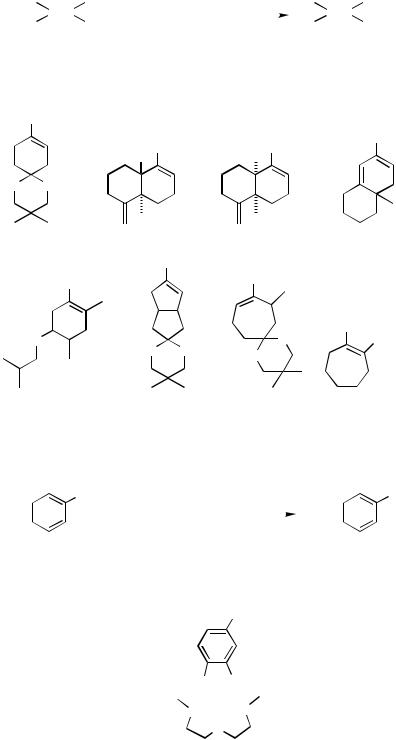
664 |
III Pd-CATALYZED CROSS-COUPLING |
|
|
|
C=C |
2 equiv LiCN |
C=C |
|
|
||
|
|
||
|
OTf |
7 mol % Pd(PPh3)4 |
CN |
|
3a−h |
7 mol % 12-crown-4 |
|
|
Benzene, r.t. |
|
|
3, Reaction time (h), Isolated yield (%), Remark[30] = 3a, 2, 80, -; 3b, 2, 89, -; 3c, 2.5, 87, -; 3d, 3, 78, -; 3e, 2, 85, -; 3f, 20, 76, Additional 7 mol % Pd(PPh3)4; 3g, 2, 78, -; 3h, 4, 59, Additional 21 mol % of Pd(PPh3)4.
OTf
OTf
OTf |
OTf |
H |
H |
O O
3a |
|
3b |
|
3c |
3d |
|
|
|
OTf |
|
|
|
|
OTf |
|
OTf |
|
|
|
|
|
|
|
|
|
|
|
O |
OTf |
|
|
|
|
||
|
|
|
|
||
O |
|
O |
O |
CO2CH3 |
|
|
|
O |
|
||
|
|
|
|
|
|
|
3e |
3f |
3g |
3h |
|
|
|
|
Scheme 19 |
|
|
|
|
|
X |
3 equiv NaCN |
|
CN |
||
|
|
|
|
|
||||
R |
|
|
|
|
R |
|
|
|
|
|
|
|
|
|
|
||
0.3 mol % trans-PhPdBr{PPh2(bc-5)}2 0.6 mol % PPh2(bc-5) Dioxane, reflux, 20 h
R, X, GLC yield (%)[33] = H, Br, 85; p-CH3, Br, 92; p-Cl, Br, 93; p-CH3O, Br, 86; H, I, 91; m-Cl, I, 87.
PPh2
PPh2(bc-5):
 O O
O O
O O
O
Scheme 20
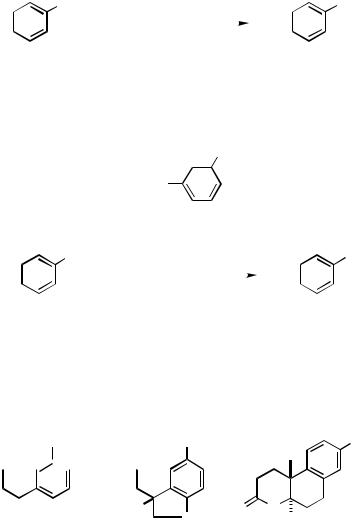
|
|
|
|
|
III.2.13.1 |
CROSS-COUPLING INVOLVING METAL CYANIDES |
665 |
|||||
|
|
|
|
|
X |
|
|
|
|
CN |
|
|
|
|
|
|
|
|
1.3 equiv NaCN, 0.5 equiv ZnCl2 |
|
|
||||
R |
|
|
|
|
|
|
|
R |
|
|
|
|
|
|
|
||||||||||
1 mol % PdCl2{PPh2(ms)}2
2 mol % NaBH4 Heptane, H2O, reflux
R (or Aryl), X, Reaction time (h), GLC yield (%), Remark[31] = p-CH3O, I, 7, 98, -; p-Cl, I, 5, 90, -; p-Br, I, 3, 82, p-CN (13%); p-CH3CO, I, 1, 97, -; p-CO2C2H5, I, 3, 94, -; m-Cl, I, 3, 98, -; m-CF3, I, 3, 98, -; o-CH3O, I, 24, 78, -; (1-Naphthyl), I, 7, 97, -; p-CN, Br, 7, 88, -; p-CH3CO, Br, 10, 95, -.
|
|
|
|
|
|
PPh2 |
||||
|
|
|
|
|
|
|
|
|
|
|
|
|
|
PPh2(ms): NaO3S |
|
|
|
|
|
||
|
|
|
|
Scheme 21 |
|
|
|
|
|
|
|
|
|
X |
|
|
|
|
CN |
||
R |
|
|
|
2 equiv NaCN |
|
R |
|
|
|
|
|
|
|
|
|
|
|||||
|
|
|
5 mol % Pd(PPh3)4 |
|
|
|
|
|||
|
|
|
|
|
|
|
|
|
||
|
|
|
|
10 mol % CuI |
|
|
|
|
|
|
R (or Aryl or 4), X, Solvent, Reaction temperature (°C), Reaction time (h), Conversion (or Isolated yield) (%), Remark[32] = p-CH3O, I, THF, -, 4, 97, KCN; H, I, THF, 1, 100, KCN; p-COCH3,
I, THF, -, 1, 100, KCN; p-NO2, THF, -, 5, 48, KCN; p-(1-pyrrolyl), CH3CN, reflux, 1, (90), -; (1-Naphthyl), I, THF, -, 1, 100, KCN; (1-Naphthyl), Br, CH3CN, reflux, 7, 97, -; (1-Naphthyl), OTf, CH3CN, reflux, 1, (90), -; (8-Quinolyl), OTf, CH3CN, reflux, 1, (87), -; (3-pyridyl), Br, C2H5CN, reflux, 4, (71), -; (5-Indolyl), Br, Valeronitrile, 115, 2, (76), -; (4a), I, CH3CN, reflux, 1, (92), -; (4a), Br, C2H5CN, reflux, 6, (91), -; (4b), I, THF, reflux, 3, (89), 1.1 equiv KCN; (4c), Br, C2H5CN, reflux, 2, (83), -.
X |
I |
Br |
Pr2N

 Pr2N
Pr2N

|
H |
O N |
|||
|
N |
|
Bz |
|
H |
|
|
|
|||
|
|
||||
|
|
|
|
Me |
|
4a |
4b |
|
4c |
||
|
Scheme 22 |
|
|
||
Electrochemical reduction provides a powerful method for maintaining the activity of the Pd0 catalyst. Following this method, catalytically inactive Pd species formed in deleterious side reactions with CN are electrochemically intercepted and restored to a catalytically active state. Under these conditions, aryl chlorides undergo cross-coupling with CN at 130 C in DMF (Scheme 24)[39] Binding to a Cr(CO)3 fragment to form the - comple is another way of activating aryl chlorides for the attack of CN in the presence of Pd0 catalyst.[28]
The Pd0-catalyzed cross-coupling with CN is applicable to heteroaryl electrophiles. In general, the reactivity of the heteroaryl electrophile is so high that substrates containing not only I , Br , or OT f but also Cl as a nucleofuge are subject to the
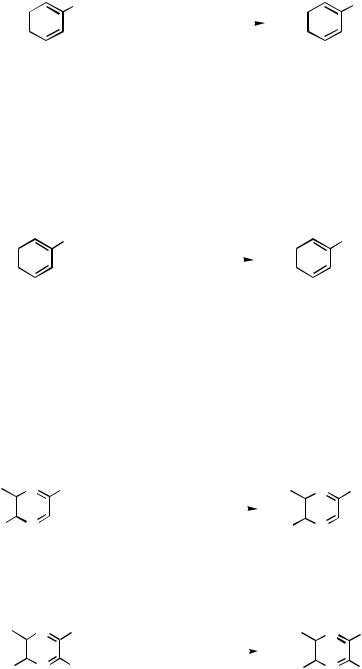
666 III Pd-CATALYZED CROSS-COUPLING |
|
|
|
|
||||
|
|
|
X |
|
|
|
CN |
|
R |
|
|
|
4 equiv CuCN |
R |
|
|
|
|
|
|
|
|
||||
|
|
|
|
|
|
|
||
4 mol % Pd2(dba)3
16 mol % dppf Dioxane, reflux
R (or Heteroaryl), X, Et4 NCN ( equiv), Reaction time (h), Isolated yield (%)[38] = p-CH3O, I, 1, 2, 82; p-CO2CH3, I, 1, 1, 88; p-NO2, I, 1, 2, 65; o-CH3O, I, 1, 1, 94; o-CO2CH3, I, 1, 1, 88; o-NO2, I, 1, 1, 67; p-CH3O, Br, 1, 3, 91; p-CO2CH3 , Br, 1, 1, 89; p-NO2, Br, 1, 3, 56;
o-CH3O, Br, 1, 1, 76; o-CO2CH3, Br, 1, 1, 83; o-NO2, Br, 1, 1, 23; (1-Phenylsulfonyl-2-indolyl), I, -, 3, 94; (1-Phenylsulfonyl-3-indolyl), I, -, 4, 99; (1-Phenylsulfonyl-2-pyrrolyl), I, -, 1, 97; (1-Phenylsulfonyl-3-pyrrolyl), I, -, 1, 69; (3,5-Dimethyl-1-phenylsulfonyl-4-pyrazolyl), I, -, 1, 90; (2-Quinolyl), Br, 1, 1, 77; (2-Quinolyl), I, -, 1, 90; (3-Quinolyl), I, -, 91; (2-Methyl-4- quinolyl), I, -, 1, 96.
|
|
|
|
Scheme 23 |
||||
|
|
|
Cl |
Et4NCN |
|
CN |
||
|
|
|
|
|
||||
R |
|
|
|
|
R |
|
|
|
|
|
|
|
0.125 mol % Pd(PPh3)4 |
|
|||
|
|
|
|
−0.3 to −0.8 V |
||||
|
|
|
|
DMF (Et4NCl incld), 130 °C |
||||
R, Catalyst turnover[39] = H, 96; p-CF3, 162; p-CH3, 2; m-CF3, 130.
Scheme 24
reaction with CN . Pyrazinecarbonitriles,[34],[40] 9H-purinecarbonitriles,[41],[42] 7H- purinecarbonitriles,[41] and 4(3H)-pyrimidinonecarbonitrile[43] are synthesized using the Pd0-catalyzed methodology (Schemes 25–28).
Cross-coupling of allyl acetates or carbonates with CN requires the catalysis of the Pd0 complex. As a cyanide source, the utility of Me3SiCN is essential for the reaction (Scheme 29).[44]
R1 |
|
N Br |
2.5−3 equiv KCN |
R2 |
|
N CN |
|
|
|
|
|
|
|
H2N |
|
N |
1.5−7.5 mol % Pd(PPh3)4 |
H2N |
|
N |
|
|
|||||
|
2.5−3 equiv CuI |
|
||||
|
|
|
7.5−8 mol % 18-crown-6 |
|
|
|
|
|
|
DMF, reflux |
|
|
|
R1, R2, Reaction time (h), Isolated yield (%)[34] = H, H, 2, 88; Br, CN, 1, 50.
Scheme 25
R3 |
|
N |
Cl |
1.5 equiv KCN |
R6 |
|
N |
CN |
|
|
|
|
|
|
|
|
|
|
|
|
|
|
|
|
|
|
R2 |
|
N |
R1 |
5 mol % Pd(PPh3)4 |
R5 |
|
N |
R4 |
|
|
|||||||
|
DMF, reflux, 2.5 h |
|
R1, R2, R3, R4, R5, R6, Isolated yield (%)[40] = H, Ph, Ph, H, Ph, Ph, 81; Ph, H, Ph, Ph, H, Ph,
31; Ph, Ph, H, Ph, Ph, H, 98; CH3, H, CH3, CH3, H, CH3, 80; i-C3H7, H, i-C3H7, i-C3H7, H, i-C3H7, 47; i-C4H9, H, i-C4H9, i-C4H9, H, i-C4H9, 77; H, Ph, CH3, H, Ph, CH3, 66; CH3, Ph, H, CH3, Ph, H, 58; i-C4H9, Cl, i-C4H9, i-C4H9, CN, i-C4H9, 76; Ph, Ph, Cl, Ph, CN, 68; Cl, Ph, Ph, CN, Ph, Ph, 16.
Scheme 26
